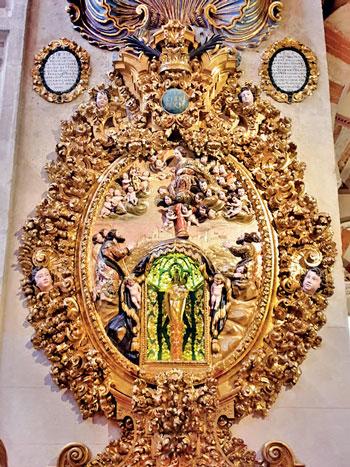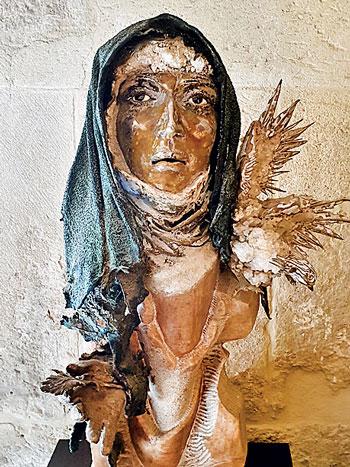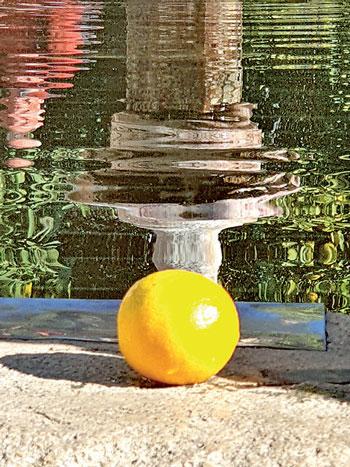05 Jul 2023 - {{hitsCtrl.values.hits}}
 Text and pictures By Tina Edward Gunawardhana
Text and pictures By Tina Edward Gunawardhana
Cordoba is a World Heritage Site. It is an old historic town with lots of meandering streets which offer interesting vistas at every turn.
About an hour’s train ride away from Seville lies Cordoba which is famous for its Great Mosque. Having heard fascinating tales about the Great Mosque it was only natural that I took a day trip to Cordoba to see the Great Mosque for myself. The train journey from Seville to Cordoba was quick and comfortable and inexpensive.
Cordoba is a World Heritage Site. It is an old historic town with lots of meandering streets which offer interesting vistas at every turn.
Initially Cordoba began as a Roman settlement and during the 10th century had become one of the most important cities in Europe. After the Muslim invasion of the Iberian Peninsular they named the region as Al-Andus and made Cordoba its capital. The city then became a centre for cultural exchange between Muslims and Christians laying the foundation for many developments both scientific and artistic.
Climbing up the small hill you can spot the imposing structure of the Great Mosque which is also known as the Mezquita- Cathedral. In the 8th century it started as a mosque and then after the Christian conquest in the 13th century it was converted into a cathedral. Due to this today one sees a mix of Christian and Islamic architectural influences in the Great Mosque.
In 1236 the Christians re-conquered Cordoba and they did with the mosque what they did in all of the cities of Andalucía. Instead of building a new church, they just “converted” the building to Christianity and set up an altar in the middle. In the 16th century, this modest gothic insert was enlarged and given its current Renaissance - and later, baroque - styles, resulting in a strange hybrid, with its ornately carved altar and pews.
The interiors of the Great Mosque immediately reminded me of our own Red Mosque in Fort and an Islamic friend of mine informed me that our Red Mosque was modelled on the Great Mosque of Cordoba.
When you go through the Puerta del Perdon and follow the path towards the Patio de los Naranjos you arrive at a courtyard which is filled with orange trees, Seville oranges of course! This is the area where Muslim worshippers used to perform their ablutions prior to entering the mosque. Today tourists sit on the rim of the fountain and bask in the shade of the orange trees during the hot sunny weather.
The distinctive feature of the Mezquita is the large number of columns which supports the roof. This is referred to as hypostyle which means filled with columns. The columns were taken from the Church of Saint Vincent which had previously occupied the site; others came from Roman and Visigothic homes in the city, and when these ran out, the Arabs made their own. But the columns were for the most part only seven or eight feet high, which meant that the huge ceiling would be aesthetically too low. So the Moors invented a double-tiered column-and-arch construction, which made it possible to increase the height of the central parts of the temple without cutting off the daylight.
The building of the mosque commenced at the end of the 8th century and was completed 200 years later. The building consisted of four distinct phases, the last and largest of which was on the north side and was carried out by the revered military leader Al-Mansur. Embedded in the inner side of the eastern wall is an octagonal chapel surrounded with high, arched windows, adorned with mosaics. This is the mihrab, a key element in all mosques which indicated the direction of Mecca.
There is also a bell tower which has a small entrance fee. However the top of the bell tower offers panoramic views of Cordoba and is well worth the climb.
The Great Mosque of Córdoba is a prime example of the Islamic world’s ability to develop architectural styles based on pre-existing regional traditions. The Great Mosque is an extraordinary combination of the familiar and the innovative that can be recognised as “Islamic” even today.



22 Nov 2024 7 hours ago
22 Nov 2024 9 hours ago
22 Nov 2024 22 Nov 2024
22 Nov 2024 22 Nov 2024
22 Nov 2024 22 Nov 2024